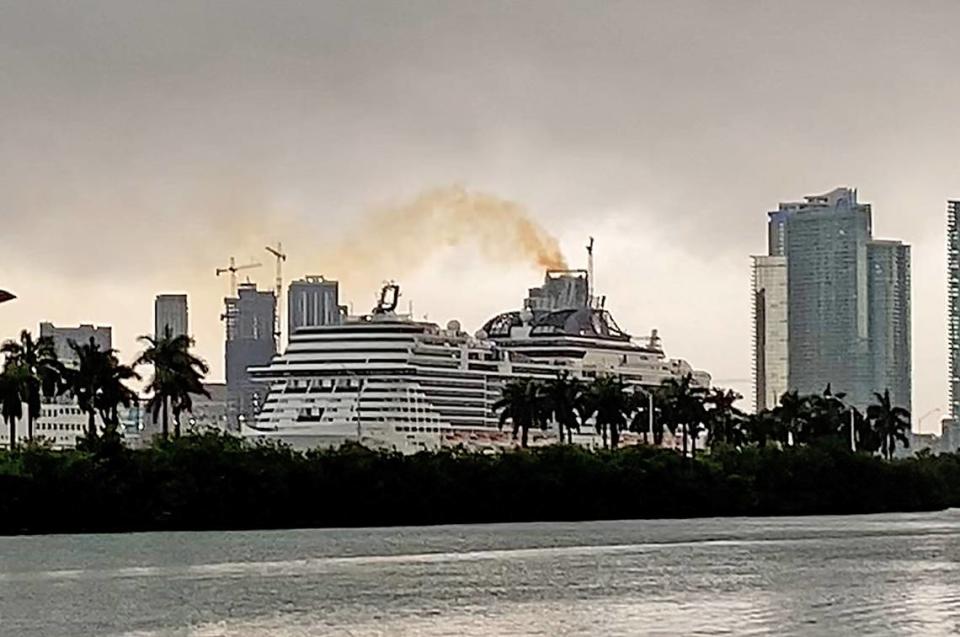Cruise lines, mayor say shore power coming to PortMiami ‘as expeditiously as possible’
Polluting cruise ships may finally be able to plug in at PortMiami, slashing emissions that harm humans and contribute to climate change.
Miami-Dade Mayor Daniella Levine Cava signed a letter of intent Wednesday with the CEOs of six cruise companies and the CEO of Florida Power & Light to bring the pollution control technology called shore power to PortMiami. The mayor announced the joint letter two weeks after the publication of a Miami Herald story about the avoidable pollution from docked cruise ships.
Representatives from the county, FPL and the companies — Carnival Corporation, Royal Caribbean Group, Norwegian Cruise Line Holdings, MSC Cruises, Disney Cruise Line and Virgin Voyages — will form a task force to work through the logistical and funding challenges of installing shore power, which allows ships to turn off their engines while docked and plug into the local electrical grid. Former Miami Beach Mayor Philip Levine will work as a volunteer with the group; he is now CEO of Royal Media Partners.
Levine Cava announced the joint letter during the Miami-Dade board of commissioners’ discussion of a new terminal for MSC Cruises that requires $177 million of public investment. The commission unanimously approved the deal with MSC, including the company’s 62-year lease on the terminal.
The joint letter does not include any timeline for installing shore power. A spokesperson for the mayor said the goal is to have at least one hookup installed within a year or two.
“We’ll be addressing many of the details moving forward,” Levine Cava said. “Today is the first crucial step.”
Shore power joint letter of... by Miami Herald
Seven U.S. ports have installed shore power for cruise ships since 2001. PortMiami first discussed installing shore power as early as 2009 as a way to protect the city from the health and climate change effects of cruise-ship emissions. Since then, the county has invested more than $700 million in building five new cruise terminals, but none of the plans include the technology.
Cruise companies have already outfitted many of their ships with the plugs necessary to connect to shore power, including at least 15 that have visited PortMiami hundreds of times in the past decade.
Spokesperson for Carnival Corp. Roger Frizzell applauded the mayor’s efforts.
“With approximately half of our fleet equipped to utilize shore power, we are strong proponents of this technology,” Frizzell said in an email.
For some residents who live near the port, the recently elected mayor’s letter is too little too late. Palm Island resident Tom Sullivan, founder of Lumber Liquidators, is tired of seeing and smelling the cruise ship exhaust from his yard. He is planning to sue the county, demanding that the MSC terminal deal and all other cruise terminal deals be amended to include shore power.
“It’s just talk, it’s nothing substantial,” he said of the joint letter. “Either they put down a timeline and have an exact plan, or we’ll make them do that.”

Attorney Melanie Damian, who is representing Sullivan, said the terminal deal does not comply with the 2035 Master Plan for PortMiami, a sub-element of Miami-Dade County’s Comprehensive Development Master Plan, which said the county would make investments in shore power in 2010, 2020, 2023, 2028 and 2033.
South Beach resident Matthew Gultanoff called the joint letter a great first step and said he’ll be watching the task force’s next steps closely.
“The MSC terminals approved today should have available shore power prior to commencement of operations,” he said.
At Wednesday’s commission meeting, Port Director Juan Kuryla said the MSC terminal could be outfitted with shore power, and that shore power will be installed at the same time as the new terminals are being built.
“It will run parallel to the actual construction of this terminal,” he said. “As part of the expansion, there is an expansion of the existing substation at PortMiami. That substation would have enough power to provide electricity to different berths.”
In addition to the MSC terminal deal approved Wednesday, two of the five new cruise terminals — Royal Caribbean Group’s Terminal A and Norwegian Cruise Line Holdings’ Terminal B — are already completed and can be retrofitted with shore power, according to experts. Two are currently under construction — Virgin Voyages’ Terminal V and Carnival Corp.’s Terminal F.
According to a 2018 report from Port Everglades, in 2008 Florida Power & Light estimated it would cost $7.5 million to equip a single cruise berth with shore power. More recently, the shore power hookup at the Brooklyn cruise terminal cost $20 million to develop.
A Miami Herald analysis of EPA data and the agency’s shore power calculator found shore power could reduce carbon emissions at PortMiami by about 35%. Emissions dangerous to human health — sulfur oxide and nitrogen oxide — would be cut by 67% and 99%, respectively. As power grids incorporate more energy from renewable sources like wind, solar and hydropower, shore power will become even more effective.
This story has been updated to clarify Philip Levine’s current position as CEO of Royal Media Partners.

